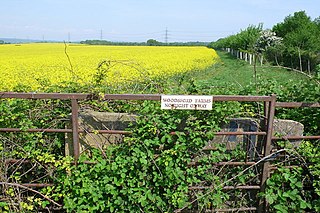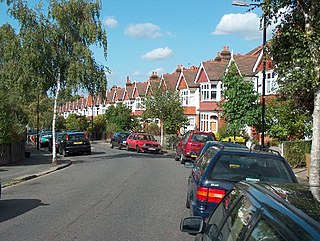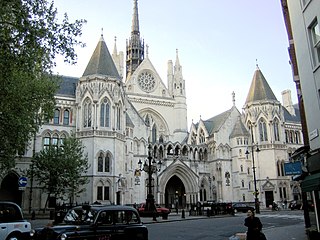This aims to be a complete list of the articles on real estate.

The freedom to roam, or "everyman's right", is the general public's right to access certain public or privately owned land, lakes, and rivers for recreation and exercise. The right is sometimes called the right of public access to the wilderness or the "right to roam".

A green lane is a type of road, usually an unmetalled rural route.
A servitude is a qualified beneficial interest severed or fragmented from the ownership of an inferior property and attached to a superior property or to some person other than the owner. At civil law, ownership (dominium) is the only full real right whereas a servitude is a subordinate real right on par with wayleaves, real burdens, security interests, and reservations. There are two types: predial, attaching to property, and personal, attaching to a person.
A dominant estate is the parcel of real property that has an easement over another piece of property. The type of easement involved may be an appurtenant easement that benefits another parcel of land, or an easement appurtenant, that benefits a person or entity. The easement may also be an affirmative easement, that permits a person to do something on the servient estate, or a negative easement that allows the holder of the easement to restrict activity on the servient estate. Estate is a common law concept.

Re Ellenborough Park[1955] EWCA Civ 4 is an English land law case which reformulate the tests for an easement. It found an easement to use a communal garden to be a valid easement in law. There is no requirement for all of the houses to be immediately next to the garden to benefit from it.
Robert Francis Brachtenbach was an American politician and jurist from the state of Washington.
An easement is a nonpossessory right to use and/or enter onto the real property of another without possessing it. It is "best typified in the right of way which one landowner, A, may enjoy over the land of another, B". It is similar to real covenants and equitable servitudes; in the United States, the Restatement (Third) of Property takes steps to merge these concepts as servitudes.
In Anglo-Saxon law, an exclusive right, or exclusivity, is a de facto, non-tangible prerogative existing in law to perform an action or acquire a benefit and to permit or deny others the right to perform the same action or to acquire the same benefit. A "prerogative" is in effect an exclusive right. The term is restricted for use for official state or sovereign powers. Exclusive rights are a form of monopoly.
M.P.M. Builders, LLC v. Dwyer, 442 Mass. 87, 809 N.E.2d 1053 (2004), was a case decided by the Massachusetts Supreme Court that first adopted the Restatement Third of Servitudes for the relocation of easements in that state.
Easements in English law are certain rights in English land law that a person has over another's land. Rights recognised as easements range from very widespread forms of rights of way, most rights to use service conduits such as telecommunications cables, power supply lines, supply pipes and drains, rights to use communal gardens and rights of light to more strained and novel forms. All types are subject to general rules and constraints. As one of the formalities in English law express, legal easements must be created by Deed.

Copeland v Greenhalf [1952] Ch 488 is an English property law case establishing that excessive use of another's land cannot be granted by way of an easement. The defendant claimed that he held a prescriptive right to leave an unlimited number of cars on his neighbour's land, by way of such a right having existed for some fifty years previously. The court found that the claim would amount to the defendant effectively becoming a joint user of the plaintiff's land, and this was not something which could be implied as a right.

Right of way is "the legal right, established by usage or grant, to pass along a specific route through grounds or property belonging to another", or "a path or thoroughfare subject to such a right". This article is mainly about access by foot, by bicycle, horseback, or along a waterway, and Right-of-way (transportation) focusses on highways, railways, pipelines, etc. A footpath is a right of way that can only be used by pedestrians.

English land law is the law of real property in England and Wales. Because of its heavy historical and social significance, land is usually seen as the most important part of English property law. Ownership of land has its roots in the Anglo-Saxon system of Bookland and in the Anglo-Saxon multiple estate, a feudal system transformed by William the Conqueror and his influx of many new chief landlords after 1066. The modern law's sources derive from the old courts of common law and equity which includes legislation such as the Law of Property Act 1925, the Settled Land Act 1925, the Land Charges Act 1972, the Trusts of Land and Appointment of Trustees Act 1996 and the Land Registration Act 2002, and the European Convention on Human Rights. At its core, English land law involves the acquisition, content and priority of rights and obligations among people with interests in land. Having a property right in land, as opposed to a contractual or some other personal right, matters because it creates privileges over other people's claims, particularly if the land is sold on, the possessor goes insolvent, or when claiming various remedies, like specific performance, in court. Capital taxation, the industrial revolution and reform of the established church has resulted in a shift from predominant ownership by the church and landed gentry to largely agricultural, minority aristocratic ownership. This means today sites for development belong to a complex web of owners able meet market demand-side forces for development, tempered by supply-side forces including the values enshrined in public planning policy to protect green spaces and promote sustainable, locally diverse and socially useful development of land.

South African property law regulates the "rights of people in or over certain objects or things." It is concerned, in other words, with a person's ability to undertake certain actions with certain kinds of objects in accordance with South African law. Among the formal functions of South African property law is the harmonisation of individual interests in property, the guarantee and protection of individual rights with respect to property, and the control of proprietary relationships between persons, as well as their rights and obligations. The protective clause for property rights in the Constitution of South Africa stipulates those proprietary relationships which qualify for constitutional protection. The most important social function of property law in South Africa is to manage the competing interests of those who acquire property rights and interests. In recent times, restrictions on the use of and trade in private property have been on the rise.

London and Blenheim Estates Ltd v Ladbroke Retail Parks Ltd [1993] 4 All ER 157 is an English land law case, concerning easements. It persuasively confirmed for one of the first times, obiter, that parking a car on land on its own could be the appropriate subject matter for an express easement. It established that an arrangement for a future extension of easement rights over specific other land would require a specific parcel of dominant land too. Simply agreeing that wherever any dominant land is extended the easement on the servient land will be extended is insufficient.

Das v Linden Mews Ltd[2002] EWCA Civ 590 is an English land law case, concerning rights of way.

Kent v Kavanagh[2006] EWCA Civ 162 is an English land law case, concerning easements. It concerns physically shared amenities with physically divided ownership as to the land or surface on which they rest.

Fremont Weir Wildlife Area is 1,461 acres at the north end of the Yolo Bypass floodway along the Sacramento River in Sutter County and Yolo County. It is 6 miles north-east of the city of Woodland and 15 miles north of Yolo Bypass Wildlife Area and the nearby Sacramento Bypass Wildlife Area. Whenever water in the river exceeds the height of the weir the excess flow runs over the weir and down the Yolo Bypass floodway, thereby reducing the risks of flooding in the city of Sacramento and nearby urban areas along the river.












